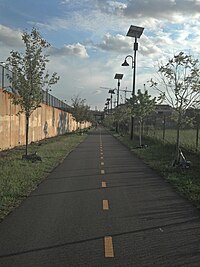Metropolitan Branch Trail
| Metropolitan Branch Trail | |
|---|---|

The Metropolitan Branch Trail
|
|
| Length | 8 miles (13 km) |
| Location | Washington, D.C. |
| Trailheads | South: Union Station, North: Silver Spring |
| Use | Hiking, Biking |
| Hiking details | |
| Website | www |
The Metropolitan Branch Trail, also called the Met Branch Trail, is an 8-mile (13 km) planned rail trail will run from the Silver Spring, Maryland Transit Center to Union Station in the District of Columbia. It serves to extend the Capital Crescent Trail where it merges with the active WMATA/CSX railroad into the National Capital. At Fort Totten a connector trail to the Northwest Branch Trail of the Anacostia Tributary Trail System at Hyattsville, Maryland will be constructed; and an on-street connection to the National Mall will be constructed from Union Station. When completed, the Metropolitan Branch Trail will serve as part of the East Coast Greenway.
Seven miles of the trail are within Washington, DC and one mile (1.6 km) is in Maryland. The trail gets its name from the Metropolitan Subdivision of the Baltimore and Ohio Railroad (B&O), which the trail parallels. The remainder of the trail closely parallels the current WMATA/CSX tracks into Maryland. It is anchored by two significant railroad landmarks, Union Station and the old B&O Railroad Station in Silver Spring.
The Metropolitan Branch Trail was first conceived in 1988, by Patrick Hare, of the Brookland neighborhood. Working with the Washington Area Bicyclist Association (WABA) and Rails-to-Trails Conservancy in 1989, Hare organized a group of eleven area cyclists to conduct an exploratory walk/ride. Soon after, motivated by CSX's plans to develop the Eckington Rail Yard needed for the trail, the Coalition for the Metropolitan Branch Trail was formed to explore and promote the potential for a multi-use trail. Prior to that the trail was sometimes called the 'Dome to Dome Trail' because it would connect the Capital Dome and the Catholic University dome. The Metropolitan Branch Trail entered the DC Comprehensive Plan in the early 1990s and in 1997 the DC Department of Public Works (DPW) completed an engineering feasibility study that proved it would be possible.
...
Wikipedia
